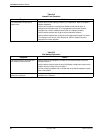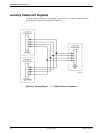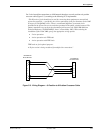
COMSPHERE 392xPlus Modems
B-4 November 1996 3920-A2-GN31-30
Table B-5
(1 of 2)
Modem — VF Connection
Symptom
Action
The modem does not receive a dial
tone.
Attach a telephone directly to the telephone line to verify that a dial tone exists.
Make sure the VF line is connected to the modem’s rear jack labeled DIAL.
The modem does not go off-hook
and answer an incoming call.
Verify that the Auto Answer Ring Count configuration option is set to a value
other than 0 (disable). Refer to
Line Dialer
in Chapter 4.
Verify that the DTE is providing DTR to the modem.
If the DTE does not provide DTR to the modem, verify that the modem’s DTR
Action configuration option is set for Ignore. Refer to
DTE Interface
in
Chapter 4.
Verify that all cables are attached to the correct connectors on the rear of the
modem.
The modem goes off-hook, answers,
but does not connect.
Perform a Local Analog Loopback test and verify that data entered at the DTE
is echoed back to the DTE.
Verify that the originating modem is compatible with your receiving modem.
Verify that the originating modem recognizes your modem’s answer tone.
Verify that the originating modem supports your modem’s modulation schemes.
The 392x
Plus
modem recognizes CCITT V.34, V.32bis, V.32, V.22bis, V.22,
V.21, Bell 212A, and Bell 103J. The 392x
Plus
modem does not support other
vendors’ proprietary modulation schemes.
Force your modem to operate at the same modulation scheme as the
originating modem to see if they connect.
The Originate Mode does not
function properly.
Verify that the modem’s DTE Dialer Type configuration option is set to the
correct setting: either AT, DTR Dialing, V.25bis Async, V.25bis Bisync, or
V.25bis HDLC. Refer to
DTE Dialer
in Chapter 4.
The modem does not go off-hook
and begin dialing.
If using AT Dialing, refer to Table B-4, Modem — DTE Connection.
If using DTR Dialing, verify the telephone number stored in directory location 1,
and verify that the DTE is raising DTR from Off to ON to initiate a dial.
If using V.25bis Async, verify that the correct character format is set to 7 data
bits with even parity and 1 stop bit, and the carriage return and line feed are
used as command terminators.
If using V.25bis Bisync, verify that the correct character format uses two
synchronous control characters and a start-of-text control character before the
text block, and an end-of-text control character after the text block.
If using V.25bis HDLC, verify that the character format uses flag, address, and
control characters before the text block and a frame sequence check and flag
after the text block.
The modem dials but does not
connect.
If the modem is operating behind a PBX, determine if a 9 and comma are
needed before the telephone number
.
Verify whether Tone or Pulse dialing is needed.
Verify that both modems are configured the same in regard to Error Control. Try
calling in Buffer mode.
If both modems use V.32bis or V
.32 modulation,
try setting the modem’
s V.32bis
T
rain configuration option to Long.


















